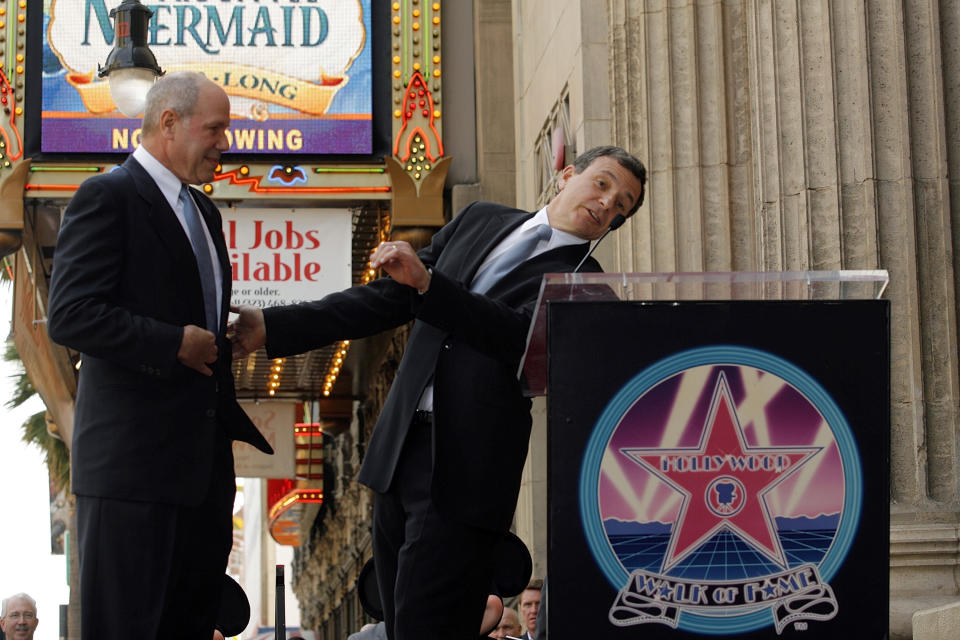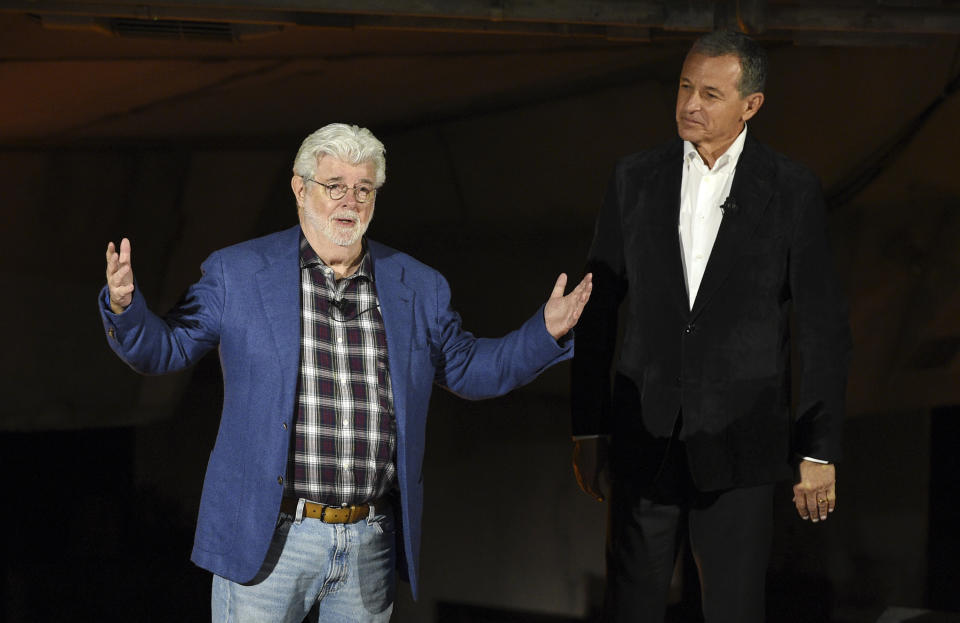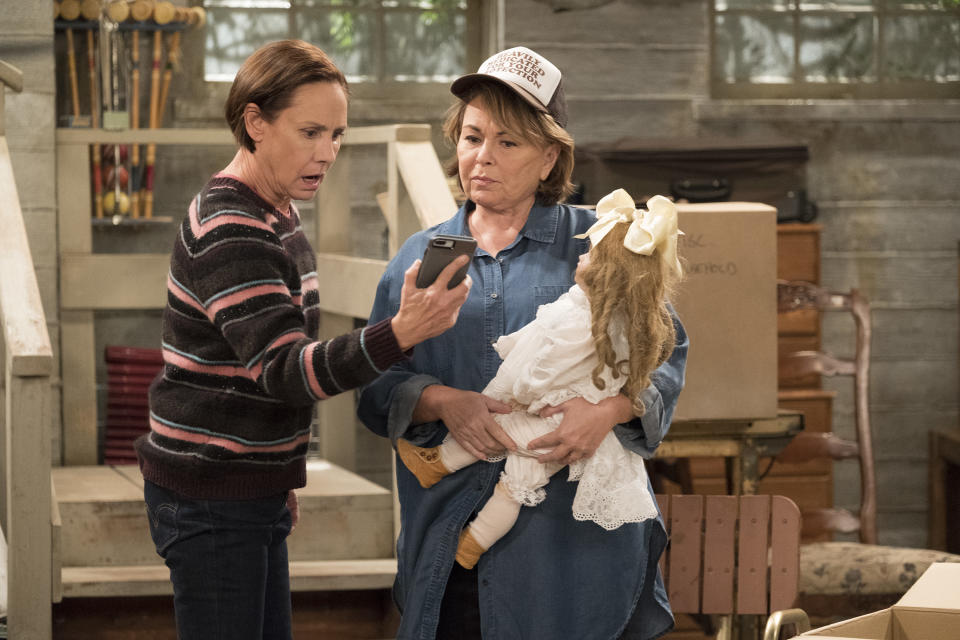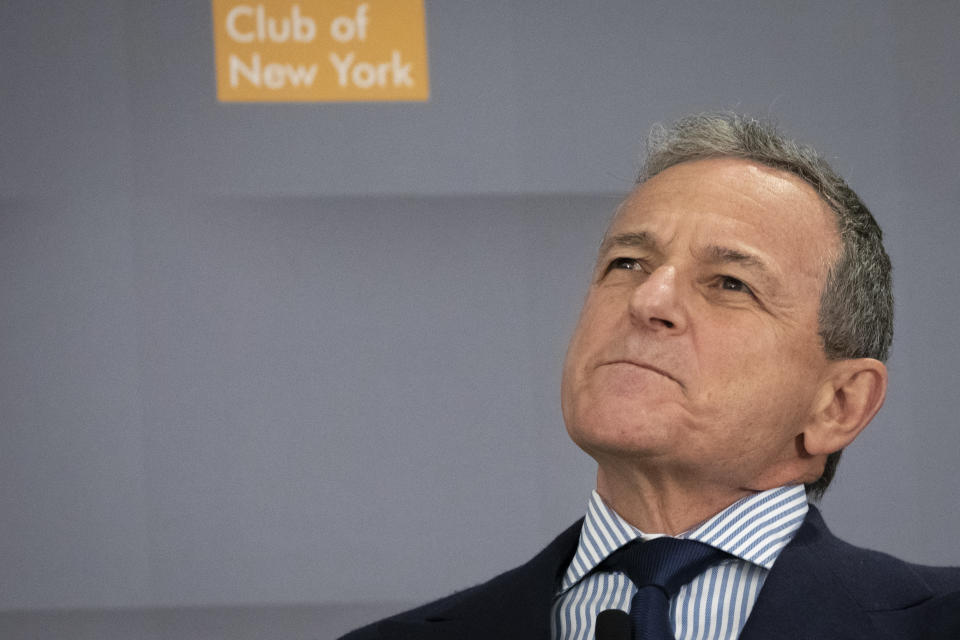5 secrets about Disney revealed in Bob Iger's book
When Disney CEO Bob Iger began working on his memoir, “The Ride of a Lifetime,” he thought that when it came out, he would no longer be CEO of Disney. He also thought it might end up coming out as he was amid a 2020 presidential run.
Disney’s (DIS) gargantuan $71.3 billion acquisition of Fox changed those expectations. Iger promised Rupert Murdoch, when they hammered out the deal, that he’d extend his tenure as Disney CEO through 2021 to oversee the integration.
Iger’s new book, which was published by Random House in September, is packaged like a standard businessperson success story, but it contains a lot of surprisingly candid reflections, and quite a few news nuggets that were not previously publicly known.
The ABC/Disney lifer speaks intimately in the book about the multiple times he almost left ABC along the way, like when Cap Cities, a much smaller local television company, bought ABC in 1985, and when Disney acquired ABC in 1995. He paints talent agent Michael Ovitz’s 15-month tenure at Disney as disastrous. He recalls times when ABC’s television lineup was flailing, and when Disney Animation’s film pipeline was flailing. And deal enthusiasts get a lot of meat about Iger’s four defining moves as Disney CEO: acquiring Pixar, Marvel, Lucasfilm, and Fox.
Here are five revealing moments from Iger’s book.
1. Michael Eisner was staunchly against the Pixar acquisition (2006)

Iger was named Disney CEO in March 2005 and immediately moved to make a big acquisition to boost Disney’s creative content. He landed on Pixar, at the time its own publicly traded company (with a market cap of around $6 billion), because Disney Animation had put out a slew of duds, and Pixar had a stream of hits, including “Toy Story 2,” “Monsters Inc.,” “Finding Nemo” and “The Incredibles.”
In January 2006, after Iger had spoken extensively about the deal with Steve Jobs, John Lasseter, and Ed Catmull, he had to go to the Disney board with the plan. Iger decided to have the Pixar trio address the Disney board directly, and he writes that he thought it went well: “The moment Steve, John, and Ed started talking, everyone in the room was transfixed.”
Before the board could vote, Iger got a call from Michael Eisner, his predecessor and his direct boss for five years while Iger was COO. Eisner was no longer even a board member, but still held sway with people on the board. “Bob, you can’t do this. It’s the stupidest thing in the world... You can fix Animation. You don’t need them to do it,” Iger recalls Eisner saying.
“It was the same list of concerns,” Iger writes. “It was too expensive, too risky. Bringing Steve [Jobs] into the company would be a disaster.”
Iger was annoyed. “Michael had been out of the company for four months. His connection with Disney had ended on his last day at work... I was offended by his meddling.”
The board eventually voted nine in favor of the Pixar deal and two against, and the vote did not need to be unanimous. Disney announced its $7.4 billion purchase of Pixar on Jan. 24, 2006.
Iger writes that Eisner “years later” admitted he was wrong about the Pixar acquisition.
2. George Lucas wanted more money for Lucasfilm (2012)

In May 2011, Iger had lunch with George Lucas after a rededication ceremony for “Star Tours” at Disney World in Orlando, Fla., and Iger raised the possibility of Lucas selling his company. Lucas was not ready to sell at the time, but was open to the idea of it happening down the road.
Seven months later, Lucas called Iger and said he was ready to talk. This time, they met for lunch at Disney Studios in Burbank, Calif. Lucas, Iger writes, promptly declared that he wanted “the Pixar deal.’”
The Pixar deal was $7.4 billion. “We already sensed Lucasfilm was potentially quite valuable for us,” Iger writes, “but it wasn’t worth $7.4 billion.” Pixar had six movies already in production when Disney bought it, plus a large staff of engineers, writers, directors, and animators. Lucasfilm had no directors other than George Lucas, and “no film development or production pipeline, as far as we knew... In George’s mind, Lucasfilm was as valuable as Pixar, but even from our relatively uninformed analysis, they weren’t.”
Iger and other Disney senior execs brainstormed what Disney might be able to launch and sell if it owned Lucasfilm, “which was pure conjecture” at that point, Iger acknowledges. They looked at Lucasfilm’s special effects business, its licensing deals for toys and other merchandise, and most importantly concluded that if they moved quickly they could put out a new “Star Wars” movie within three years, in 2015, and put out another in 2017 and another in 2019.
Iger called Lucas and said Disney could pay between $3.5 billion and $3.75 billion. Lucas had “come way down” from the Pixar price, but still “was not going to accept anything lower than Marvel,” Iger writes. (In 2009, Disney had bought Marvel for $4 billion.) They settled on $4.05 billion—symbolically “slightly above what we paid for Marvel,” Iger writes.
The deal went through, but that wasn’t the end of disagreements between Lucas and Disney. When Lucasfilm president Kathleen Kennedy screened “The Force Awakens” for Lucas privately, he was unhappy. Iger disagreed and was very pleased with the direction in which JJ Abrams had taken the film. He still wanted Lucas to attend the “Force Awakens” premiere, and Lucas did, and it went well. But after the film came out (and quickly smashed records for the biggest opening weekend ever), an interview Lucas did with Charlie Rose came out in which Lucas said the “Star Wars” movies were like “his kids” and he felt he had sold them to “white slavers,” i.e. Disney. Iger writes that he “decided to stay quiet and let it pass.”
Lucas’s wife Mellody Hobson sent Iger an apology email, and later, Lucas called and did the same.
3. Bob Iger changed his mind on buying Twitter at the last minute, Jack Dorsey was ‘stunned’ (2016)

After the “dust settled,” as Iger writes, on three giant acquisitions of content companies (Pixar, Marvel, Lucasfilm), Disney wanted to buy a technology platform. It looked at buying Snapchat, Spotify, and Twitter. “They were all digestible in terms of size,” Iger writes.
Disney landed on Twitter and expressed interest to Twitter in 2016, but that prompted Twitter to court other offers, so Disney “reluctantly entered into an auction” to buy Twitter, and came to terms. (Iger confirmed in 2017 rumors that Disney had considered buying Twitter, but he did not say why; he was cagey and only said, “We decided ultimately not to go in that direction.”) Twitter’s board approved the deal, and Disney’s board approved it on a Friday in October 2016.
The next day, Iger writes, “I decided not to go through with it. Something inside me didn’t feel right... There were brand-related issues that gnawed at me.”
Iger says he noted “controversies” with Twitter that troubled him, including “how to manage hate speech... what to do about fake accounts algorithmically spewing out political ‘messaging’ to influence elections, and the general rage and lack of civility that was sometimes evident on the platform.” (Just last month, Twitter CEO Jack Dorsey announced Twitter would no longer allow political advertising.)
Twitter’s problems, Iger writes, “would become our problems. They were so unlike any we’d encountered, and I felt they would be corrosive to the Disney brand.” He called Twitter CEO Jack Dorsey, who “was stunned, but very polite.”
Instead of buying Twitter, Disney exercised its option to buy a controlling stake in MLB Advanced Media’s spun-off video business BAM Tech, one year after it spent $1 billion for a 33% stake. BAM Tech would become crucial in powering ESPN+ and Disney+.
4. Iger personally made the decision to fire Roseanne Barr and cancel her show (2018)

In May 2018, just two months after ABC brought back “Roseanne” and it premiered to huge ratings, the show’s star Roseanne Barr sent a tweet that called Valerie Jarrett, former adviser to President Obama, the “baby” of “Muslim brotherhood & planet of the apes.” The tweet was widely condemned as racist and inexcusable, though Barr later claimed she thought Valerie Jarrett was white.
Iger powwowed with a cadre of Disney and ABC Entertainment executives, and they discussed “a variety of responses which ranged from a suspension and loss of pay to a severe warning and public rebuke.” While the other executives “didn’t mention firing her, I knew it was in the backs of their minds,” Iger writes.
Ultimately, Iger himself decided they had to fire Barr and cancel the show. He reasoned that, “If any of our employees tweeted what she tweeted, they’d be immediately terminated.” He adds in the book, “It was an easy decision, really. I never asked what the financial repercussions would be, and didn’t care.”
Iger says he received calls of praise from Patriots owner Bob Kraft and President Obama, among others—but “I was attacked on Twitter by President Trump, who asked where my apology was for him and said something about the ‘horrible’ statements we’d made about him while reporting the news on ABC.”
5. Iger considered running for president—until the Fox deal came together (2017)

In August 2017, two weeks after Disney announced its purchase of the BAM Tech majority stake, Rupert Murdoch invited Iger to his winery in Bel Air, Calif. Iger assumed Murdoch wanted to find out whether Iger planned to run for president in 2020, a rumor that had been circulating, and Iger was right: Murdoch asked him immediately. “I had no desire to be candid with Rupert about my thinking, figuring it would end up on Fox News,” Iger writes.
In fact, Iger had indeed been considering a run for president, “even though I knew it was a terrific longshot,” he writes. He had done extensive homework to school himself on political history and policy. He even reread the U.S. Constitution and the Bill of Rights.
“I was also trying not to be presumptuous,” he writes. “The simple fact that I ran a large multinational company did not necessarily qualify me to be President of the United States.” Iger also adds, quite candidly, in a moment that possible 2020 candidate Michael Bloomberg might want to take note of, “I was skeptical of the Democratic Party’s willingness and ability to support a successful business person.”
What happened after the politics question with Murdoch ended Iger’s presidential run consideration anyway: Iger felt Murdoch suggested he was willing to sell 21st Century Fox. The next day he called Murdoch and they discussed it more overtly; Murdoch said he would only sell if Iger extended his tenure as CEO; Iger at the time was slated to step down in June 2019. Iger writes: “I suddenly had the feeling that my life was about to change, and a run for the presidency wasn’t going to be the catalyst.”
Nearly two years later, after a prolonged bidding war in which Comcast was also in the mix, Disney finally closed its $71.3 billion acquisition of Fox’s entertainment assets. Iger will remain CEO until 2021.
—
Daniel Roberts is a senior writer and show host at Yahoo Finance and closely covers Disney. Follow him on Twitter at @readDanwrite.
Read more:
Disney reveals what it will do with Hulu
Disney’s next Marvel movie phase should scare box-office competitors
Sinclair buys 21 former Fox regional sports networks from Disney
Disney+ has a secret weapon: millennial nostalgia
